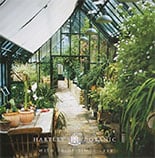
“Water adds life, movement, and sound,” says Vanca Lumsden. For fourteen years she was the owner of Pondering, an aquatic plant and supply business in Medford, Oregon. She says, “Even plants growing in still water add a whole new dimension to the greenhouse.”
Whether it’s a fountain or simply containers where aquatic plants can thrive, water adds humidity to help other plants in the greenhouse. There’s also the easy-care factor. Aquatic plants don’t dry out when you’ve gone away for a while. Just top them up when you get back. They tend to be tough. “You don’t learn to breathe under water if you’re a wimp,” Vanca notes.

Because of those proclivities, some weedy water plants can be grown indoors, but should never be allowed out in the natural world. Check with your state’s noxious weed list and if you still want those plants in the greenhouse, handle with care when removing them. Use proper disposal guidelines. Dry them out completely before adding to the compost. Or, better yet, bag and add to the garbage. Many of these weeds are still sold, such as floating fairy fern, Azolla spp., which can double in size in four or five days. “Beautiful, but dreadful,” Vanca says.

When hunting for aquatic candidates, Vanca suggests looking at their second scientific names. “Words like aquatica, or palustris, which means boggy ground, will tell you they’re suited to growing in water,” she says.
And some plants, such as cannas, will grow on either land or water. “The roots are different for each location,” Vanca says. “So you acclimate them slowly, putting their pots in a small amount of water first, and then raising it inches at a time, over several week, That way, they can respond with a specific set of roots. If you just throw them into a deeper situation all at once, they may drown.”
A bouquet of plants in their own pots will grow in one large container of standing water. For freshness, you can employ an array of filters, both mechanical or biological. Or find underwater oxygenator plants, available at any fish store. And the plants themselves will help keep everything clean. Vanca prefers to simply change out the water once a year.

Worried about mosquitos? Vanca suggests sprinkling the water surface with mosquito dunk flakes, or topping off the water so it spills over the sides, dumping any larvae.
If you want the sight and sound of flowing water, Vanca cautions that many plants don’t like to grow near the splash. “Floating plants, like water hyacinth or water lettuce do the best,” she says. “And, you don’t usually need as much water sound as you think you do—especially indoors.”
Vanca suggests experimenting with the noise of splashing. Put a spoon under the kitchen faucet with water flowing into a bowl. Turn it front to back and notice the difference. This helps you tune in to what you want to hear. You can also select a pump that has an adjustable flow rate and test a variety of sounds.
Here are a few of Vanca’s suggestions for evergreen plants that will serve you well in the greenhouse.

- Acorus ‘Ogon’ – At a foot tall and wide, this variegated green and gold grasslike foliage will brighten any container. The erect bloom spike (spadix) can bend over and seed itself nearby.
- Aponogeton distachyos – Water hawthorn’s long-flowering and fragrant blooms hover near the surface in cooler weather, dying down for a brief time in the hottest weather and re-emerging for more show.
- Cyperus alternifolius – Umbrella palm grows best to four feet in standing water. There are smaller cultivars as well.
- Pontederia cordata spp. – A North American native perennial, the species of upright blue flowers of pickerelweed stand three feet above the water. Cultivars can be pink or white.










